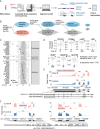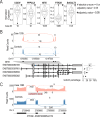Assessing the diagnostic impact of blood transcriptome profiling in a pediatric cohort previously assessed by genome sequencing
- PMID: 40593860
- PMCID: PMC12215727
- DOI: 10.1038/s41525-025-00505-4
Assessing the diagnostic impact of blood transcriptome profiling in a pediatric cohort previously assessed by genome sequencing
Abstract
Despite advances in genome sequencing, many individuals with rare genetic disorders remain undiagnosed. Transcriptional profiling via RNA-seq can reveal functional impacts of DNA variants and improve diagnosis. We assessed blood-derived RNA-seq in the largely undiagnosed SickKids Genome Clinic cohort (n = 134), which has been subjected to multiple analyses benchmarking the utility of genome sequencing. Our RNA-centric analysis identifies gene expression outliers, aberrant splicing, and allele-specific expression. In one-third of diagnosed individuals (20/61), RNA-seq reinforced DNA-based findings. In 2/61 cases, RNA-seq revised diagnoses (EPG5 to LZTR1 in an individual with a Noonan syndrome-like disorder) and discovered an additional relevant gene (CEP120 in addition to SON in an individual with ZTTK syndrome). Additionally, ~7% (5/73) of undiagnosed cases had at least one plausible candidate gene identified. This study highlights both the benefits and limitations of whole-blood RNA profiling in refining genetic diagnoses and uncovering novel disease mechanisms.
© 2025. The Author(s).
Conflict of interest statement
Competing interests: MBrudno and DJS have equity in PhenoTips. SWS, RC, CRM and AS are affiliated with this journal as Editors or Editorial Board Members. These co-authors are not part of a peer review process or decision making of the manuscript. The other authors declare no competing interests.
Figures




Similar articles
-
Clinical applications of and molecular insights from RNA sequencing in a rare disease cohort.Genome Med. 2025 Jul 1;17(1):72. doi: 10.1186/s13073-025-01494-w. Genome Med. 2025. PMID: 40597352 Free PMC article.
-
Signs and symptoms to determine if a patient presenting in primary care or hospital outpatient settings has COVID-19.Cochrane Database Syst Rev. 2022 May 20;5(5):CD013665. doi: 10.1002/14651858.CD013665.pub3. Cochrane Database Syst Rev. 2022. PMID: 35593186 Free PMC article.
-
Uncommon Non-MS Demyelinating Disorders of the Central Nervous System.Curr Neurol Neurosci Rep. 2025 Jul 1;25(1):45. doi: 10.1007/s11910-025-01432-8. Curr Neurol Neurosci Rep. 2025. PMID: 40591029 Review.
-
Clinical and analytical validation of a combined RNA and DNA exome assay across a large tumor cohort.Commun Med (Lond). 2025 Jun 16;5(1):236. doi: 10.1038/s43856-025-00934-3. Commun Med (Lond). 2025. PMID: 40523952 Free PMC article.
-
Comprehensive mutational profiling identifies new driver events in cutaneous leiomyosarcoma.Br J Dermatol. 2025 Jan 24;192(2):335-343. doi: 10.1093/bjd/ljae386. Br J Dermatol. 2025. PMID: 39392932
References
Grants and funding
LinkOut - more resources
Full Text Sources

